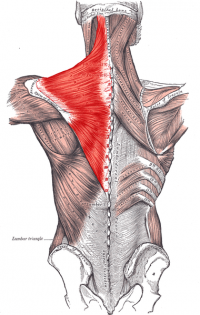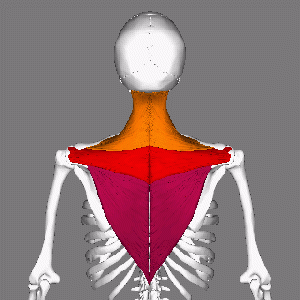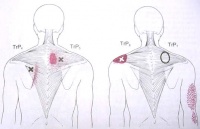Trapezius
Original Editor - Daphne Jackson
Lead Editors - Lucinda hampton, Andeela Hafeez, Kim Jackson, Kai A. Sigel, Daphne Jackson, WikiSysop, Joao Costa, Rachael Lowe, Evan Thomas, Tarina van der Stockt and Kirenga Bamurange Liliane
Description[edit | edit source]
The trapezius is a broad, flat, superficial muscle extending from the cervical to thoracic region on the posterior aspect of the neck and trunk. The muscle is divided into three parts: descending (superior), ascending (inferior), and middle[1]. The muscle contributes to scapulohumeral rhythm through attachments on the clavicle and scapula, and to head balance through muscular control of the cervical spine.
Origin[edit | edit source]
The muscle attaches to the medial third of superior nuchal line; external occipital protruberance, nuchal ligament, and spinous processes of C7 - T12 vertebrae[2].
Insertion[edit | edit source]
The muscle inserts on the lateral third of clavicle, acromion, and spine of scapula[2].
Nerve Supply[edit | edit source]
- Spinal root of accessory nerve (CN XI) (motor)[2]
- Cervical nerves (C3 and C4) (pain and proprioception)[2]
Blood Supply[edit | edit source]
Transverse cervical artery (cervicodorsal trunk)[2][1]
Function[edit | edit source]
The superficial muscles of the back (trapezius, latissimus dorsi, rhomboids, levator scapula, serratus anterior) contribute to extension and side flexion of the axial skeleton. The cervical extensor muscles (descending trapezius and cervical erector spinae) counterbalance the pull of gravity on the head, as the head tends to be pulled into flexion due to its anterior centre of gravity[3]
Action[edit | edit source]
- Descending part: elevates pectoral girdle[1]
- Middle part: retracts scapula[1]
- Ascending part: depresses shoulders[1]
- Descending and ascending together: rotates scapula upwards[1]
- Bilateral contraction: extends neck[4]
- Unilateral contraction:
functional contributation[edit | edit source]
The trapezius muscle is a postural and active movement muscle, used to tilt and turn the head and neck, shrug, steady the shoulders, and twist the arms. The trapezius elevates, depresses, rotates, and retracts the scapula, or shoulder blade.[5]
Trigger Point Referral Pattern[edit | edit source]
Recent Related Research (from Pubmed)[edit | edit source]
Failed to load RSS feed from http://www.ncbi.nlm.nih.gov/entrez/eutils/erss.cgi?rss_guid=1bCr63ThlO2_EjapuTs-VVGCD3KOFO-M4fiVC5BoBJ1z-APsgV|charset=UTF-8|short|max=10: Error parsing XML for RSS
References[edit | edit source]
- ↑ 1.0 1.1 1.2 1.3 1.4 1.5 Moore KL, et al. Essential clinical anatomy. 4th ed. Baltimore, MD: Lippincott Williams and Wilkins, 2011.
- ↑ 2.0 2.1 2.2 2.3 2.4 Department of Radiology, UW Medicine. Trapezius. www.rad.washington.edu/academics/academic-sections/msk/muscle-atlas/upper-body/trapezius (accessed 27 January 2014).
- ↑ Kisner C, Colby LA. Therapeutic exercise: foundations and techniques. 6th ed. Philadelphia: F.A. Davis Company, 2012
- ↑ 4.0 4.1 4.2 Neumann DA. Kinesiology of the musculoskletal system: foundations for rehabilitation. 2nd ed. St. Louis, MO: Mosby Elsevier, 2010.
- ↑ http://www.healthline.com/human-body-maps/trapezius-muscle











